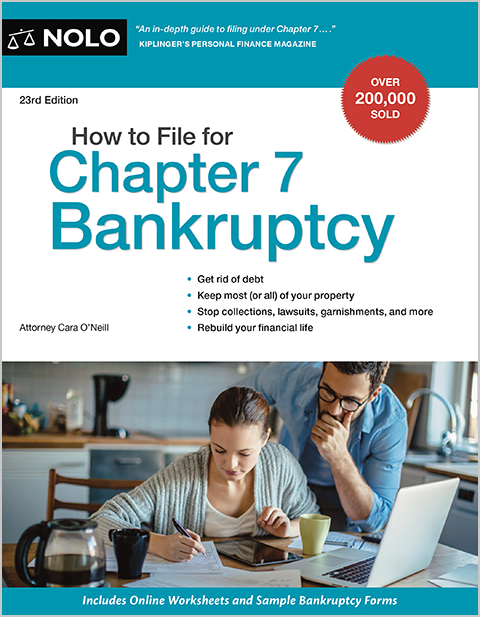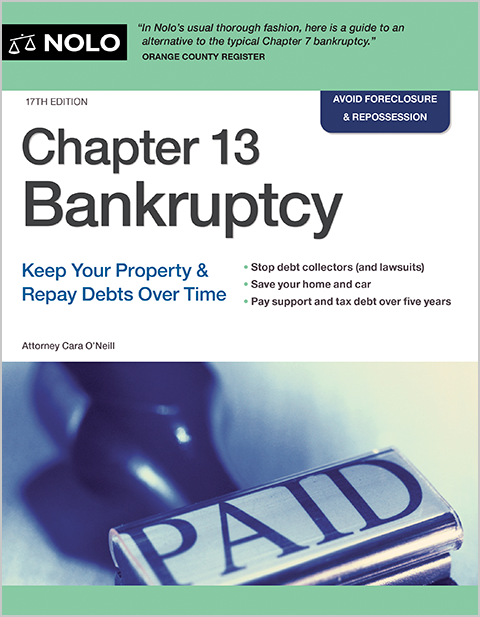On Schedule C of the bankruptcy petition, you list all of the property you claim is exempt.
Schedule C: The Property You Claim as Exempt is the official bankruptcy form you use to list and claim exemptions for property you want to protect when filing for Chapter 7 or Chapter 13 bankruptcy. It's where you list all the property you're legally entitled to keep because it's "exempt." Schedule C is one of the many bankruptcy forms you must complete when filing for bankruptcy.
What Is Exempt Property and Why Is It Important?
While many people worry that they won't get to keep any of their property when they file for bankruptcy, this isn't true. The law allows you to retain property needed to live and work.
Each state has a set of bankruptcy exemption laws you can use to protect your property. Some states allow you to choose between the state exemptions and the federal exemption scheme.
- Exemptions in Chapter 7. If you list the exempt property on Schedule C, you get to keep it.
- Exemptions in Chapter 13. If you want to keep more property than you can exempt, you can pay for the nonexempt portion in the Chapter 13 plan and retain the property.
How Do I Complete Bankruptcy Schedule C?
The steps above will guide you through the process. Here's more about the information you'll need to provide:
- Exemption system you're using. In the first section, you have to check one of two boxes. Your choice tells the court whether you will use the federal exemption system or your state exemption system. (11 U.S.C. § 522(b)(2),(3).) However, not every state allows you to choose between the federal and state systems. Most require you to use the state exemptions. Because of residency requirements, some filers won't qualify to use any state's system. If that happens, you can use the federal exemptions.
- Description of property. In the first column of Schedule C, you must describe each item of property or each asset you are claiming as either fully or partially exempt (it will only be partially exempt if the value exceeds the exemption amount). Use the same property description you used in Schedule A/B.
- Schedule A/B line number. Check Schedule A/B and find the line where you originally listed the property. In the first column, insert that line number where it says "Line from Schedule A/B." This helps prevent confusion about the particular property you're exempting.
- Current value of the portion you own. In the second column of Schedule C, you'll enter the current replacement value of the portion you own and are claiming as exempt. If you're the only owner, you'll write down the entire value. If you and someone else own the property on a 50/50 basis, you'll declare half of the value. Use the information you already provided on Schedule A/B to keep the figures consistent. Also, make sure it matches the value on Schedule D: Creditors Who Have Claims Secured by Property, if applicable.
- Amount of exemption you claim. In the third column, you have two choices. If your exemption schedule only allows you to exempt a certain dollar amount, check the first box and insert that number. If, however, the exemption statute allows you to exempt an unlimited dollar amount, check the second box, "100% of fair market value, up to the applicable statutory limit."
- Specific laws that allow the exemption. In the fourth column of Schedule C, you'll provide the statutory citation (the code number for the law that allows for the exemption) that gives you the legal right to exempt that item. If you aren't sure about this, you should consult with legal counsel. Find out more about state bankruptcy exemptions.
- Claiming a homestead exemption of more than $214,000. If you aren't using state exemptions that provide a homestead exemption greater than $214,000, check no. Check yes if you are using state exemptions that provide a homestead exemption greater than $214,000 (you're only likely to do this if you have more than $214,000 of equity in your home). Check yes again if you acquired the property within 1,215 days of filing the petition. In certain situations, your homestead exemption may be capped at $214,000. (11 U.S.C. § 522(p); amount current for cases filed between April 1, 2025, and March 31, 2028.)
You can find the most recent Schedule C version on the U.S. Court's website.
Frequently Asked Questions About Bankruptcy Schedule C
Below you'll find answers to common questions about and related to Schedule C.
- What is the purpose of bankruptcy Schedule C?
- What happens if I list property incorrectly?
- Can I file Chapter 7 bankruptcy multiple times?
- What is the difference between federal and state bankruptcy exemptions?
- Can I choose between federal and state exemptions?
- How do I determine the value of property on Schedule C?
- How do homestead caps work?
- Do exemptions affect repayment in Chapter 13?
What is the purpose of bankruptcy Schedule C?
Bankruptcy Schedule C is used by debtors to list all property they claim as exempt from their creditors. This allows them to keep essential assets after filing for bankruptcy.
What happens if I list property incorrectly?
You'll want to report the error to the trustee as soon as possible. It's essential to be accurate and forthright when reporting property. Intentionally omitting assets or misstating values can have serious consequences, including possible case dismissal, fines, and criminal prosecution.
Can I exempt all of my property in bankruptcy?
Many people can, but it isn't guaranteed. You're limited by the specific type and value of property allowed in either your state's bankruptcy exemptions, or the federal bankruptcy exemptions. Property exceeding exemption limits is sold in Chapter 7 and must be paid for in Chapter 13 through the Chapter 13 plan.
What is the difference between federal and state bankruptcy exemptions?
Federal exemptions are a nationwide standard set of property exemptions that are often used when a bankruptcy filer doesn't meet state residency requirements. Most states require residents to use the state bankruptcy exemptions, but some states allow filers to use the federal bankruptcy exemptions. Debtors with a choice can usually choose one system or the other, but not both.
Can I choose between federal and state exemptions?
Most states require filers to use the state exemptions, but some allow the filer to choose between the two sets. Check your state's rules.
How do I determine the value of property on Schedule C?
You should list the current value of the portion of the property you own. This is not necessarily the purchase price, but what the item would be worth at the time of filing.
How do homestead caps work?
If you owned your home less than 1,215 days, federal law limits your exemption to $214,000 as of April 2025.
Do exemptions affect repayment in Chapter 13?
Yes. The more nonexempt property you keep, the higher your minimum unsecured creditor payments.
Need More Bankruptcy Help?
Did you know Nolo has made the law accessible for over fifty years? It's true, and we wholeheartedly encourage research and learning. You can find many more helpful bankruptcy articles on Nolo's bankruptcy homepage. For instance, Nolo articles will explain what bankruptcy can do, what you'll want to avoid before filing for bankruptcy, and more. Information needed to complete the official downloadable bankruptcy forms is on the Department of Justice U.S. Trustee Program website.
However, online articles and resources can't address all bankruptcy issues and aren't written with the facts of your particular case in mind. The best way to protect your assets in bankruptcy is by hiring a local bankruptcy lawyer.

